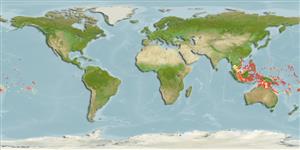Common names from other countries
Environment: milieu / climate zone / depth range / distribution range
بوم شناسي
دريايي وابسته به آب سنگ; تغييرات عمق 0 - 50 m (Ref. 90102), usually 0 - 15 m (Ref. 90102). Tropical; 19°N - 24°S
Pacific Ocean: Philippines to the Society Islands, south to New Caledonia. Replaced in the western Indian Ocean by Photoblepharon steinitzi (Ref. 37816).
Size / Weight / سن
Maturity: Lm ? range ? - ? cm
Max length : 12.0 cm TL جنس نر / بدون خواص جنسي; (Ref. 9710)
خارهاي باله پشتي (کل) : 2 - 3; شعاع نرم باله پشتي (کل) : 16 - 20; خارهاي باله مخرجي: 2; شعاع نرم باله مخرجي: 13 - 15.
Occurs along seaward reefs near or along steep drop-offs with caves (Ref. 9710). In some areas it may approach the surface (Ref. 9710). Usually feeds in large groups away from the reefs at night. Well hidden in caves during the day and rarely seen; often observed at 10-30 m at night (Ref. 48635).
Life cycle and mating behavior
Maturities | تولید مثل | Spawnings | Egg(s) | Fecundities | توزاد ( لارو)
McCosker, J.E. and R.H. Rosenblatt, 1987. Notes on the biology, taxonomy, and distribution of flashlight fishes (Beryciformes: Anomalopidae). Jap. J. Ichthyol. 34(2):157-164. (Ref. 5004)
وضعيت در فهرست قرمز IUCN (Ref. 130435)
CITES (Ref. 128078)
Not Evaluated
خطر برای انسان ها
Harmless
استفاده انسانی
ماهي گيري – شيلات: از بی علاقه گی; آكواريوم: تجاري
ابزارها
گزارش های ويژه
بارگيری XML
منابع اينترنتي
Estimates based on models
Preferred temperature (Ref.
115969): 26.2 - 29.3, mean 28.6 (based on 1756 cells).
Phylogenetic diversity index (Ref.
82804): PD
50 = 0.7520 [Uniqueness, from 0.5 = low to 2.0 = high].
Bayesian length-weight: a=0.01122 (0.00514 - 0.02450), b=3.04 (2.87 - 3.21), in cm Total Length, based on all LWR estimates for this body shape (Ref.
93245).
Trophic level (Ref.
69278): 3.5 ±0.5 se; based on size and trophs of closest relatives
Fishing Vulnerability (Ref.
59153): Low vulnerability (10 of 100).
